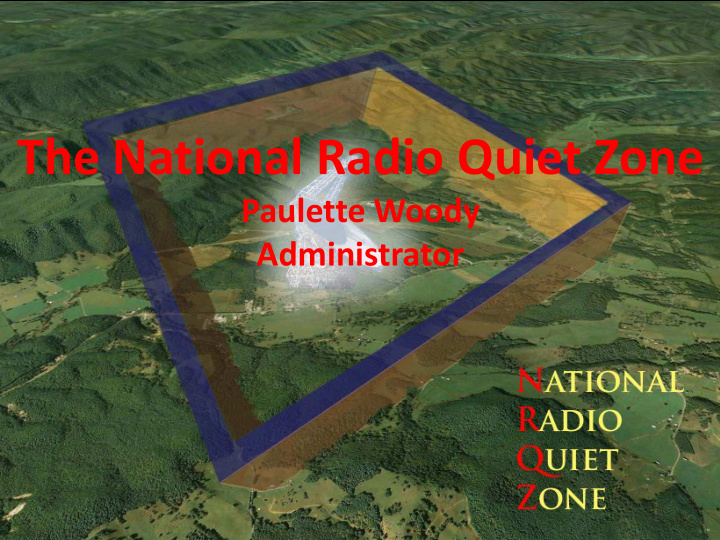



The National Radio Quiet Zone Paulette Woody Administrator
How did the NRQZ form and Why is it here? 2
January 1954 – Conference in Washington sponsored by NSF, Cal Tech, Carnegie Institute of Washington
January 1954 – Conference in Washington sponsored by NSF, Cal Tech, Carnegie Institute of Washington If the United States is to keep abreast of developments in radio astronomy, our scientists must have at their disposal larger and more powerful research equipment than is now available to them… there are no instruments in this country comparable with the large steerable paraboloid under construction in England, nor with the large interferometer arrays in Australia and England. The cost of such equipment places it beyond the likely means of any single institution. An observatory available to all qualified scientists is an obvious solution for the problem of inadequate research facilities. (R. Emberson, AUI, 1954)
The level of radio noise or interference … must be extraordinarily low . T o avoid noise the following conditions are necessary: 1. The telescopes should be within the view of the smallest possible number of close-by inhabitants who might generate noise in the course of their daily work. 2. The telescopes should not view high tension power lines that radiate radio noise through corona discharges or otherwise. 3. The site should be in a valley surrounded by as many ranges of high mountains in as many directions as possible, to attenuate direct radio propagation from neighboring radio stations and to reduce diffraction of tropospheric propagation into the valley. 4. The site should be at least 50 miles distant from any city or other concentration of people or industries, and should be separated from more distant concentrations by surrounding mountain ranges.
National Forest Around Green Bank Green Bank
Topography Around Green Bank
National Radio Quiet Zone • NRAO founded in Green Bank, WV in 1956 • NRQZ established by: – the Interdepartment Radio Advisory Committee (IRAC) in Document 3867/2 (March 26, 1958) – the Federal Communications Commission (FCC) in Docket No. 11745 (November 19, 1958) • Established in law before radio telescopes were built and before any frequency allocations to Radio Astronomy were made. • +13,000 square mile area in West Virginia, Virginia and small portion of Maryland.
Its purpose is to restrict radiation so as to minimize possible interfer Purpose of the NRQZ To restrict radiation so as to minimize possible interference on the operations the NRAO in Green Bank, W.V., and the Sugar Grove Research Station in Sugar Grove, WV. It is the only designated quiet zone in the US; a one of a kind, unique, and irreplaceable resource.
NRQZ Coordination Process • As part of the normal coordination process, the NRQZ office comments on new or modified, permanent, fixed, licensed radio transmitters. • Works with applicants in finding a mutually acceptable solution to their coverage needs and our protection criteria.
WV Radio Astronomy Zoning Act • Up to a 10 mile restriction zone • Involves any electrical equipment source, such as VSAT installations
How do we coordinate transmitters?
Only bounded area in the US requiring coordination of new or modified, permanent, fixed, licensed transmitters.
US Frequency Allocations Chart
Fixed Transmitters in the NRQZ (Rich Mountain near Elkins, WV)
Evaluation Parameters Site specific information for all evaluations: 1. Coordinates (to decimal second accuracy) 2. Ground elevation (AMSL) 3. Antenna height (centerline) 4. Operating frequency or frequency band(s) 5. Occupied bandwidth (Emission designator) 6. Analysis
Antenna Gain: + 9 dBd 56 dBm Line Loss: 3 dB Analysis results are compared to our protection TX criteria to determine if the 100 Watts site is a potential source for (+50 dBm) harmful interference.
Factors in The Evaluation Process Power Transmitted in the Natural Obstacles direction of the GBT (depends (mountains) in the path on the antenna and what (if the attenuation direction it is pointing as well manmade obstacles is as the power into the known, this too can be antenna) considered) Frequency and Bandwidth over which the power is Path Length distributed (depends on the technology being used)
Propagation Study…. point to point Your transmitter The GBT …our prime instrument
Propagation Study Text Softwright TAP Terrain Analysis Program USGS 10 meter data Longley Rice Rounded obstacle Obstacle information Path attenuation
Mitigation efforts: Directional Antenna systems, etc Transmitter output power reduction Change of main beam Azimuth bearing Reduction in antenna height Use of directional or beam- forming type antenna systems All requested power restrictions are directional from the transmitter to the GBT.
"Radio Frequency Management is done by experts who meld years of experience with a curious blend of regulation, electronics, politics and not a little bit of larceny. They justify requirements, horse-trade, coerce, bluff and gamble with an intuition that cannot be taught other than by long experience." VADM Jon L. Boyes U.S. Navy (Ret.) Adm. Boyes was a three-star admiral , the second-highest rank in the Navy. After graduating in 1943 from the U.S. Naval Academy through an accelerated program, he served in World War II in the Pacific, where he was wounded in a Japanese attack on his ship. After the war, he became a submarine commander.
Recommend
More recommend